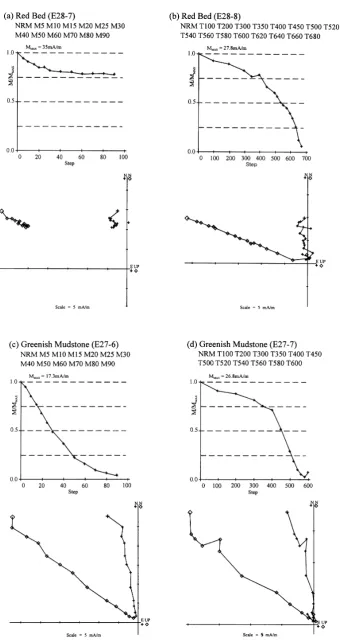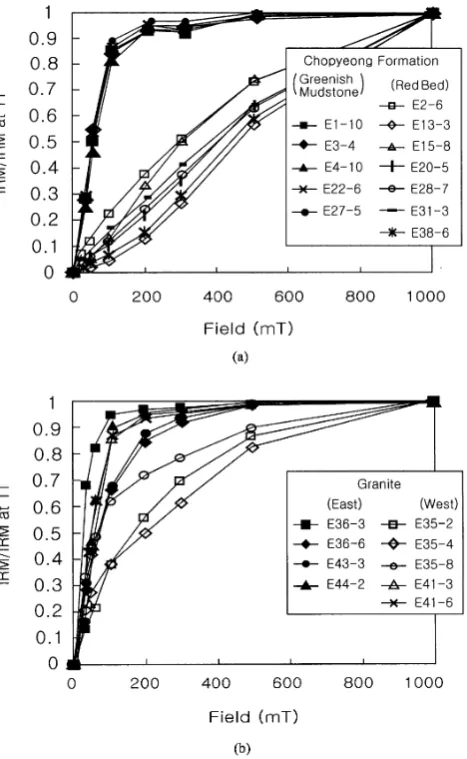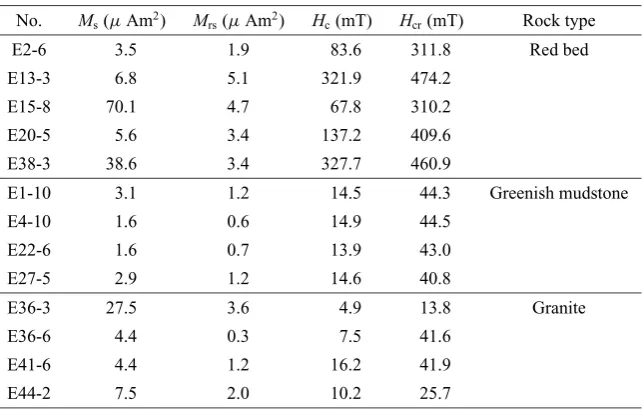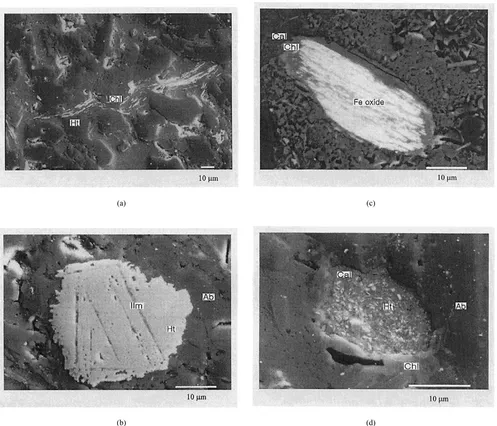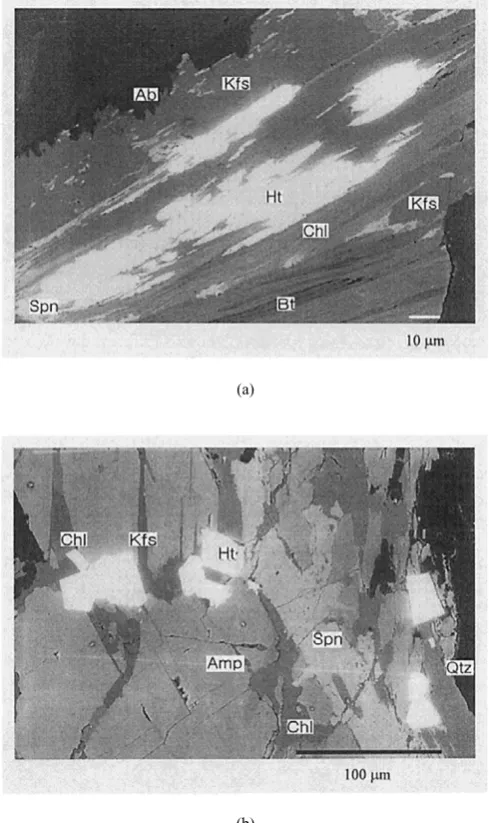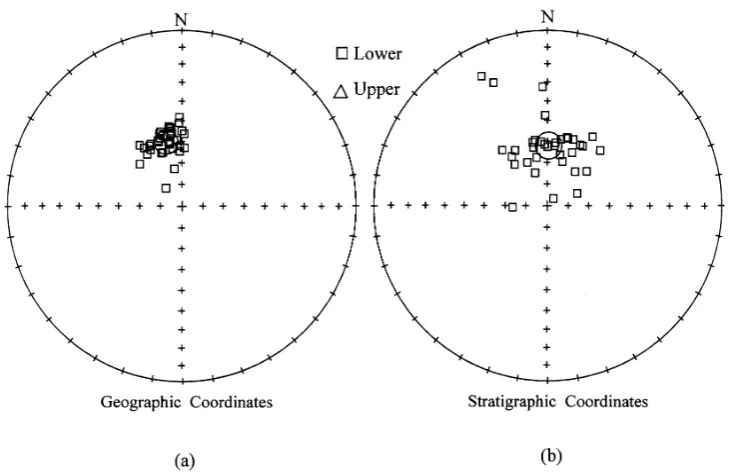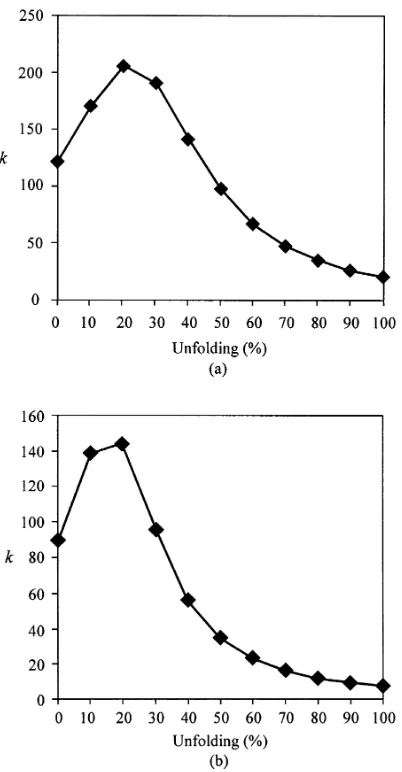Earth Planets Space,51, 337–349, 1999
Paleomagnetic and rock magnetic studies of Cretaceous rocks
in the Eumsung basin, Korea
Seong-Jae Doh1, Dong-Woo Suk2, and Bang-Yeon Kim1
1Department of Earth and Environmental Sciences, Korea University, Seoul, 136-701, Korea 2Department of Earth and Marine Sciences, Hanyang University, Ansan, 425-791, Korea
(Received August 15, 1998; Revised November 3, 1998; Accepted March 29, 1999)
Paleomagnetic results are obtained from 41 sites from the Chopyeong Formation within the Eumsung basin, located along the northern boundary of the Ogcheon Belt, Korea. The Chopyeong Formation, deposited in early Cretaceous, yields the mean direction of D/I = 347.8◦/57.3◦ (k = 92.8, α95 = 2.5◦) before tilt correction, and D/I =0.7◦/61.7◦ (k =19.6, α95 = 5.5◦) after tilt correction. The parameter estimating fold test and the stepwise unfolding test of the red bed and greenish mudstone of the Chopyeong Formation yield the maximum value of k at 21.9% and at 20% untilting, respectively, indicating that the remanence whose mean direction of
D/I =350.8◦/57.9◦ (k =177.9,α95 =1.8◦) at 20% untilting was acquired during or after tilting of the strata. The comparison of the paleomagnetic pole from the Chopyeong Formation with those from the Youngdong basin and the Euiseong area in the Gyeongsang basin indicates that the remanence was acquired during late Cretaceous to early Tertiary. Electron microscope observations and rock magnetic experiments show that secondary hematite and magnetite grains of single domain to pseudo-single domain size were authigenically formed under the influence of fluids presumably triggered by the igneous activities, thus confirm the chemical remagnetization.
It is revealed that the age of the granite in the east is Jurassic because the mean direction of the east granite (D/I =347.0◦/47.7◦,k=40.2,α95=3.6◦) is similar to the Jurassic direction of Korea Peninsula. The age of the granite in the west, however, is left undetermined whether it is Cretaceous or Jurassic because of the weak intensity and instability of the remanence of the granite during demagnetization treatments.
1.
Introduction
Paleomagnetism is a useful tool to estimate the age of rocks and to detect tectonic disturbance that might cause de-flection of paleomagnetic directions. Paleomagnetic data are also used to reconstruct the large scale tectonic movement. In Korea, many paleomagnetic studies were carried out for Cretaceous rocks mainly from the Gyeongsang basin in the southeastern part of the Korea Peninsula. Cretaceous basins in South Korea can be sorted into three groups by their areal distributions. The Gyeongsang basin is composed of three sub-basins and occupies the largest area compared to other Cretaceous basins. The second one comprises small-sized basins, compared to the Gyeongsang basin, and is distributed along the Ogcheon Belt. The third group consists of basins located in the Kyeonggi massif parallel to the boundary of the Ogcheon Belt. The Eumsung basin, occupying along the northern boundary of the Ogcheon Belt, is mainly composed of Cretaceous sedimentary rocks within strike-slip fault sys-tem (Fig. 1).
A few paleomagnetic studies for Cretaceous rocks from basins other than the Gyeongsang basin have been carried out (Leeet al., 1992; Cho, 1994; Wonet al., 1994), com-pared to many paleomagnetic studies for the Gyeongsang basin (e.g., Minet al., 1982; Otofujiet al., 1982, 1986; Kim
Copy right cThe Society of Geomagnetism and Earth, Planetary and Space Sciences (SGEPSS); The Seismological Society of Japan; The Volcanological Society of Japan; The Geodetic Society of Japan; The Japanese Society for Planetary Sciences.
and Cheong, 1986; Leeet al., 1987; Kim and Kim, 1991; Kim
et al., 1993; Doh and Kim, 1994; Dohet al., 1994). Only one paleomagnetic study for the Eumsung basin has been done by Leeet al.(1992). In that study, results from just 5 samples of 1 site were reported, which can hardly be consid-ered as representative directions of the strata in the Eumsung basin. In this study, paleomagnetic results from Cretaceous rocks in the Eumsung basin are presented by comparing the results with those from the Gyeongsang basin and other Cre-taceous basins in order to clarify the magnetic and tectonic characteristics of the basin.
In terms of the age of granites in the study area, Cheong
et al.(1976) suggested that the granite in the eastern part of the basin is Jurassic in age, and that of the granite in the west is Cretaceous. However, Chunet al.(1994) recently argued that the granite in the west to the basin formed in Jurassic. A paleomagnetic investigation of the granites in the Eumsung basin is carried out to constrain the age of the granites utiliz-ing the timutiliz-ing of the magnetization of the granites.
2.
Geologic Setting
The Eumsung basin is a pull-apart basin formed between left-stepping sinistral “master” strike slip faults, and filled with Cretaceous sedimentary rocks which were named as the Chopyeong Formation (Chunet al., 1994). Precambrian gneiss and Jurassic granite comprise the basement of the basin and volcanic rocks are distributed along the eastern boundary of the basin (Lee and Kim, 1971; Cheonget al.,
Fig. 1. Geologic map of the Eumsung basin, showing the locations of the paleomagnetic sampling sites (after Chunet al., 1994).
1976; Kanget al., 1980; Leeet al., 1989).
The ages of the granites in the eastern and the western parts of the basin were thought to be Jurassic and Cretaceous, re-spectively (Cheonget al., 1976). However, recently Chun et al.(1994) claimed that the age of the granite in the west-ern part is Jurassic, because of cataclastic texture at the fault contact of the granite with sedimentary rocks and presence of perthite, a feldspar mineral formed in a plutonic rock by slow cooling of magma, in sandstones collected from central to western part of the basin. The granite outside the western boundary, therefore, must be the source rock of the sedimen-tary rocks in the western part of the basin and predate the Cretaceous sedimentary rocks.
The Chopyeong Formation consists of various sedimen-tary rocks, that can be divided into 3 lithofacies; conglomer-ate facies, greenish mudstone facies, and purplish mudstone facies (Fig. 1). Conglomerate facies is confined along the margin of the basin, and the inner part of the basin isfilled with greenish and purplish mudstones, containing lenticular beds of sandstone and clasts-bearing sandstones. Microfos-sils of Charophytes are found only in greenish mudstone facies (Choiet al., 1995). This succession is considered to be formed in a stream dominated alluvial to lacustrine
de-positional environment. Sediments are thought to be mainly derived from the nearby rocks, such as Precambrian gneiss, Jurassic granite, and syn-depositional volcanic rocks (Chun et al., 1994).
After the formation of sedimentary basin, the strata have been deformed three times (Chunet al., 1994). Thefirst de-formation was caused by the sinistral strike-slip fault which reactivated the master faults and adjacent faults of the same attitude in the basin. The second and third deformations were caused by the NW-SE and the ENE-WSW sinistral strike-slip fault which cut through the master faults. The folds devel-oped in the sedimentary rocks were formed by the sinistral strike-slip faulting and tilting along the master faults and by the similarly oriented faults. The folds are wide open and have the NNE to NE trend with low angle of plunging axis in the central part of the basin and NE-SW trend in the marginal parts of the master faults.
3.
Field and Laboratory Methods
In thefield, samples were cored with a gasoline-powered portable drill and oriented with magnetic and sun compasses. There were no significant differences between magnetic and sun compass azimuths. 765 samples from 41 sites were col-lected: 31 sites from red bed (purplish mudstone facies and interlayered siltstone beds in conglomerate facies), 5 sites from greenish mudstone, and 5 sites from granite (Fig. 1).
In the laboratory, samples were cut into 2.2 cm long cylin-ders. Remanent magnetization of specimens was measured using a Molspin spinner magnetometer. To determine suit-able demagnetization method for the specimens of each site, pilot samples were demagnetized either by alternatingfield (AF) demagnetization or by thermal demagnetization. AF demagnetization was performed at thefield strength of 5–30 mT with 5 mT interval and 40–90 mT with 10 mT interval us-ing a Molspin AF demagnetizer. Thermal demagnetization was performed at 100, 200, 300, 350, 400, 450, 500, and for temperature range of 520–700◦C with 20◦C intervals using an ASC Scientific thermal demagnetizer (model TD-48). To monitor possible chemical changes of magnetic carriers on heating, magnetic susceptibility was measured at each step of thermal demagnetization using a Bartington magnetic sus-ceptibility meter (model MS2). The samples were stored in mu-metal boxes to prevent from acquisition of viscous rema-nence by the external magneticfield. The remaining speci-mens were demagnetized using the suitable method for each site. The orthogonal vector diagrams (Zijderveld, 1967) for paleomagnetic data were plotted in order to identify the di-rections of characteristic remanent magnetization (ChRM) for each specimen employing the principal component anal-ysis (PCA) with anchored linefit method (Kirschvink, 1980) using at least three or more data points presumably follow a linear segment of a trajectory. Mean directions for individ-ual sites and formations were calculated using Fisher (1953) statistics. Specimens showing maximum angular deviation greater than 15◦ and/or revealing directions quite different from the rest of the specimens within a site were not included for site mean calculation.
S.-J. DOHet al.: PALEOMAGNETIC AND ROCK MAGNETIC STUDIES OF CRETACEOUS ROCKS 339
Table 1. Paleomagnetic results from the Chopyeong Formation in the Eumsung basin.
SITE VGP
Lithology Site n/N Long. Lat. Dg Ig Ds Is k α95 Long. Lat. dp dm
E2 9/10 127.52 36.81 351.9 61.6 357.5 32.3 263.0 3.2 83.8 81.4 3.8 4.9
Red bed E5 16/17 127.51 36.84 317.5 61.2 16.5 56.5 253.6 2.3 60.4 57.1 2.7 3.5
E6 9/12 127.51 36.84 328.3 59.7 29.4 56.9 344.0 2.8 55.9 65.1 3.2 4.2
E7 16/17 127.58 36.85 326.9 54.6 354.2 59.6 243.4 2.4 43.9 63.3 2.4 3.4
E8 24/25 127.58 36.85 334.2 56.3 17.4 66.8 209.0 2.1 45.4 69.4 2.2 3.0
E9 17/19 127.58 36.85 333.4 58.6 47.0 64.9 217.7 2.4 52.5 69.0 2.6 3.6
E10 55/55 127.58 36.85 341.6 56.0 13.3 64.7 43.7 2.9 41.9 75.3 3.0 4.2
E11 21/21 127.56 36.85 343.6 55.4 359.1 47.8 281.3 1.9 38.5 76.8 1.9 2.7
E12 18/18 127.56 36.86 342.6 57.3 7.1 59.8 162.3 2.7 47.2 76.2 2.9 3.9
E13 16/16 127.56 36.85 343.5 53.0 347.3 61.7 416.9 1.8 28.7 76.1 1.7 2.5
E14 19/19 127.56 36.85 345.0 52.4 6.3 60.4 213.7 2.3 24.6 77.1 2.2 3.2
E15 27/27 127.56 36.86 347.5 53.7 6.3 61.3 92.0 2.9 26.8 79.5 2.8 4.0
E16 20/20 127.56 36.86 358.2 63.0 25.6 62.3 82.1 3.6 118 82.3 4.4 5.7
E17 15/15 127.56 36.86 327.9 56.4 358.9 60.7 378.2 2.0 47.6 64.5 2.1 2.9
E18 14/14 127.56 36.86 350.6 59.2 20.7 55.9 303.3 2.3 63.5 82.0 2.6 3.4
E19 18/20 127.56 36.87 0.8 53.5 321.0 56.5 71.8 4.1 294.3 87.1 4.0 5.7
E20 29/29 127.57 36.13 2.1 55.2 324.8 61.7 123.5 2.4 230.1 88.3 2.4 3.4
E21 14/14 127.57 36.87 358.9 50.6 349.9 58.3 107.5 3.9 317.2 84.4 3.5 5.2
E23 19/19 127.57 36.89 354.1 58.8 335.6 66.1 92.0 3.5 69.2 84.7 3.9 5.2
E24 23/23 127.57 36.88 354.7 54.6 18.2 56.7 158.4 2.4 16.9 85.4 2.4 3.4
E28 16/17 127.58 36.91 349.3 72.0 132.7 18.4 62.5 4.7 111.4 68.7 7.3 8.3
E29 10/10 127.58 36.9 346.5 55.0 337.5 73.6 280.7 2.9 34.4 79.0 2.9 4.1
E30 22/22 127.58 36.9 352.9 52.6 329.7 60.0 157.2 2.5 7.1 83.1 2.4 3.4
E31 18/18 127.58 36.9 353.9 54.0 36.8 68.9 300.1 2.0 13.9 84.5 2.0 2.8
E32 19/19 127.58 36.9 349.9 54.2 345.9 66.1 223.9 2.2 25.8 81.5 2.2 3.1
E33 23/23 127.58 36.9 353.2 56.9 265.8 73.2 208.7 2.1 45.8 84.6 2.2 3.1
E34 18/18 127.58 36.91 343.8 52.8 66.4 75.3 100.9 3.5 27.4 76.3 3.3 4.8
E37 22/22 127.59 36.89 351.4 50.7 348.1 59.3 363.0 1.6 2.5 81.0 1.5 2.2
E38 24/24 127.59 36.89 355.2 51.4 321.0 65.2 207.4 2.1 348.3 83.8 1.9 2.9
E39 23/23 127.59 36.89 354.0 59.6 43.2 53.8 268.1 1.9 76.6 84.1 2.1 2.9
E40 20/20 127.58 36.88 356.5 56.8 32.5 50.8 268.8 2.0 48.8 87.2 2.1 2.9
Mean 31 347.0 56.8 121.6 2.4 45.9 79.6 K =66.3
1.0 62.2 21.4 5.7 A95=3.2
E1 20/21 127.52 36.79 322.4 77.7 336.8 24.3 46.3 4.8 103.4 53.4 8.4 9.0
Greenish E3 10/11 127.52 36.81 3.5 61.4 11.5 57.5 292.4 2.8 151.7 83.7 3.3 4.3
mudstone E4 15/16 127.52 36.84 340.9 62.5 27.4 56.8 123.2 3.5 69.2 73.9 4.3 5.5
E22 14/19 127.56 36.9 358.9 50.6 349.9 58.3 107.5 3.9 116 72.5 2.5 2.9
E27 21/21 127.57 36.92 359.4 47.1 41.8 85.9 267.3 1.9 311.1 81.3 1.6 2.5
Mean 5 353.5 60.4 34.8 13.1 99.1 77.3 K =22.0
358.9 58.4 10.7 24.6 A95=16.7
Mean 36/36 347.8 57.3 92.8 2.5 53.7 79.8 K =49.7
0.7 61.7 19.6 5.5 A95=3.4
n/N: number of samples used in average/measured; Dg andIg: declination and inclination in geographic coordinates; Ds andIs: declination and
inclination in stratigraphic coordinates;k: Fisherian precision parameter;α95: radius of cone of 95% confidence interval; VGP: virtual geomagnetic pole; dp: the semi axis of the confidence ellipse along the great-circle path from site to pole;dm: the semi axis of the confidence ellipse perpendicular to that
great-circle path;K: the best-estimate of the precision parameterkfor the observed distribution of site-mean VGPs;A95: the radius of the 95% confidence
S.-J. DOHet al.: PALEOMAGNETIC AND ROCK MAGNETIC STUDIES OF CRETACEOUS ROCKS 341
Fig. 3. Typical AF demagnetization results of the samples from (a) granite in the west to the basin showing abrupt directional changes and (b) granite in the east to the basin revealing gradual decrease toward the origin: normalized intensity curve and Zijderveld diagram in geographic coordinates. Demagnetization steps are shown below the sample number.
Table 2. Paleomagnetic results from the granites in the Eumsung basin.
SITE VGP
Lithology Site n/N Long. Lat. Dg Ig k α95 Long. Lat. dp dm
Western E35 17/17 127.58 36.95 325.5 63.1 8.3 13.2 64.9 63.0 16.4 20.8
granite E41 15/15 127.59 36.98 16.4 52.8 22.8 7.9 76.1 228 7.2 10.5
Mean 32/32∗ 354.6∗ 59.9∗ 9.1 8.8 74.1 82.9 K =8.3
A95=103.0
Eastern E36 12/15 127.62 36.91 333.7 43.0 85.6 4.7 17.1 64.6 3.6 5.8
granite E43 12/12 127.64 36.86 2.9 44.2 55.0 5.9 294.1 78.8 4.6 7.4
E44 14/14 127.61 36.79 349.1 54.2 476.3 1.8 27.7 80.9 1.8 2.5
Mean 38/41∗ 347.0∗ 47.0∗ 40.2 3.6 33.3 77.6 K =33.3
A95=21.7
Mean 5 350.5 52.8 29.9 14.2 21.1 81.5 K =18.7
A95=18.2
n/N: number of samples used in average/measured; Dg andIg: declination and inclination in geographic coordinates; k: Fisherian
precision parameter;α95: radius of cone of 95% confidence interval; VGP: virtual geomagnetic pole;dp: the semi axis of the confidence
ellipse along the great-circle path from site to pole;dm: the semi axis of the confidence ellipse perpendicular to that great-circle path;K:
the best-estimate of the precision parameterkfor the observed distribution of site-mean VGPs;A95: the radius of the 95% confidence circle
about the calculated mean pole; Western granite: granite in the western area of the basin; Eastern granite: granite in the eastern area of the basin;∗mean directions calculated as if all specimens were of the same sites for Western and Eastern granites.
parameters were measured with a vibrating sample magne-tometer (Molspin Ltd., model VSM Nuvo). Electron micro-scope observations were carried out to confirm the
4.
Paleomagnetic Results
4.1 Chopyeong Formation
Among the total of 36 sites from the Chopyeong Forma-tion, 31 sites are from red bed and 5 sites are from the greenish mudstone facies. The number of sites in greenish mudstone is much less because available outcrops are very limited in the area.
The natural remanent magnetization (NRM) directions of the Chopyeong Formation are predominantly northerly pos-itive, clustering more closely about the present-field direc-tion (D/I =352.6◦/52.9◦) than the mean axial dipolefield (D/I = 0◦/56.3◦), suggesting that the NRMs are merely dominated by components of viscous origin.
From demagnetization of pilot samples of red bed, ther-mal demagnetization is turned out to be the most effective method to isolate the characteristic component from the red bed because AF demagnetization even at thefield strength of 90 mT cannot remove the remanent magnetization suc-cessfully (Fig. 2(a)). The low temperature component, a viscous remanent magnetization (VRM) component, can be removed in the initial demagnetization stage of temperature at or below 300◦C. Above 300◦C, a converging component appears up to 620–640◦C heating steps, and then the direc-tion starts to randomize with the increase of susceptibility but the magnetic intensity decreases continuously until 680◦C (Fig. 2(b)). The ChRM was isolated mainly from 300◦C to 640◦C. The mean direction of the ChRMs from the red bed isD/I =347.0◦/56.8◦(k=121.6,α95 =2.4◦) before tilt correction and D/I = 1.0◦/62.2◦(k =21.4, α95 = 5.7◦) after tilt correction. The site-mean direction of red bed is more dispersed after tilt correction.
Both AF and thermal demagnetization methods are effec-tive to isolate ChRM direction for the greenish mudstone (Figs. 2(c) and (d)). For the ChRMs isolated using an AF demagnetization method, the low coercivity component is re-moved below 15 mT and then the characteristic component is isolated above 20 mT. The mean direction of the greenish mudstone is D/I =353.5◦/60.4◦ (k = 34.8,α95 = 13.1) before tilt correction and D/I = 358.9◦/58.4◦ (k = 10.7, α95 =24.6◦) after tilt correction. Tilt corrected directions are more dispersed than in-situ directions, indicating greenish mudstone acquired the remanence after tilting of the strata. The mean direction of the Chopyeong Formation including red and greenish beds is D/I = 347.8◦/57.3◦ (k = 92.8, α95 = 2.5◦) before tilt correction and D/I = 0.7◦/61.7◦ (k=19.6,α95=5.5◦) after tilt correction (Table 1). 4.2 Granite
Granites show two different demagnetization behaviors. Because samples from the western part of the study area gen-erally show unstable remanent directions and abrupt changes in intensity (Fig. 3(a)), it is difficult to isolate the ChRMs. In contrast, samples from the eastern part show stable rema-nent directions and gradual decrease of intensity (Fig. 3(b)). In the samples from the western granite, the characteris-tic components are determined at 5–15 mT, whereas the ChRMs for the eastern granite are isolated at 20–60 mT. The paleomagnetic mean direction of the two granite bodies isD/I =350.5◦/52.8◦(k =29.9,α95 =14.2◦) (Table 2). The paleomagnetic directions representing the granites in the east and in the west are, however, separately
recalcu-lated as if they were site-mean directions for the east and west granites because of the statistically meaningless num-ber of sites for each granite. The mean direction, calcu-lated in this way, of the east granite isD/I =347.0◦/47.7◦ (k = 40.2, α95 = 3.6◦) and that of the west granite is
D/I =354.6◦/59.5◦(k=9.1,α95=8.8◦).
5.
Rock Magnetic Results
5.1 IRM acquisition experiment
IRM acquisition experiment is employed to distinguish magnetic carriers whether they are members of magnetite-ulvospinel series or hematite-ilmenite series. Magnetite is¨
usually saturated infield of<150 mT, while thefield required to saturate hematite ranges from 200 mT for coarse specular hematite to 2 Tesla or more for fine pigmentary hematite (Piper, 1987).
The samples of this study can be grouped on the basis of the behavior of IRM acquisition. First, all samples from greenish mudstone of the Chopyeong Formation and granite in the east to the basin, and samples from site 41 of the west granite show steeply inclining IRM intensity to afield of 100 mT and about 90% saturation is achieved at 200 mT (Fig. 4). This behavior suggests that ferrimagnetic material makes an
S.-J. DOHet al.: PALEOMAGNETIC AND ROCK MAGNETIC STUDIES OF CRETACEOUS ROCKS 343
(a) (b)
Fig. 5. Typical hysteresis loops from (a) red bed and (b) greenish mudstone of the Chopyeong Formation.
Table 3. Hysteresis parameters of selected samples.
No. Ms(μAm2) Mrs(μAm2) Hc(mT) Hcr(mT) Rock type
E2-6 3.5 1.9 83.6 311.8 Red bed
E13-3 6.8 5.1 321.9 474.2
E15-8 70.1 4.7 67.8 310.2
E20-5 5.6 3.4 137.2 409.6
E38-3 38.6 3.4 327.7 460.9
E1-10 3.1 1.2 14.5 44.3 Greenish mudstone
E4-10 1.6 0.6 14.9 44.5
E22-6 1.6 0.7 13.9 43.0
E27-5 2.9 1.2 14.6 40.8
E36-3 27.5 3.6 4.9 13.8 Granite
E36-6 4.4 0.3 7.5 41.6
E41-6 4.4 1.2 16.2 41.9
E44-2 7.5 2.0 10.2 25.7
Ms: Saturation Magnetization;Mrs: Saturation Remanence;Hc: Coercive Force;Hcr: Coercivity
of Remanence.
Fig. 6. Hysteresis properties and domain state for the selected samples. Open square: red bed; solid square: greenish mudstone; solid triangle: granite (after Dayet al., 1977).
(a) (c)
(b) (d)
Fig. 7. Secondary electron image of the samples from red bed ((a), (b)) and greenish mudstone ((c), (d)) of the Chopyeong Formation showing hematite and magnetite. (a) Hematite (Ht) formed along the cleavages of chlorite (Chl). (b) Detrital hematite adjacent to albite (Ab) with ilmenite (Ilm) lamella. (c) Submicron sized iron oxides also formed along the cleavages of chlorite (Chl). (d) Hematite (Ht, white needle shaped grains) within the calcite matrix (Cal, light grey).
5.2 Hysteresis parameters
Hysteresis parameters are measured from the representa-tive samples of red bed and greenish mudstone. Small cylin-drical samples of 7 mm in diameter and 10 mm in height were prepared for hysteresis measurements. Hysteresis loops were obtained on a Molspin Nuvo vibrating sample magnetometer. Saturation magnetization (Ms), saturation remanence (Mrs), and coercive force (Hc) were determined after corrections of the magnetic moment for highfield paramagnetic and dia-magnetic slope. Remanent coercivity (Hcr) was obtained from stepwise backfield demagnetization of samples given IRM. Hysteresis loops from red bed show typical results of hematite (Fig. 5(a)) and those of greenish mudstone display typical results of magnetite (Fig. 5(b)).
Hysteresis parameters, such as Ms, Mrs,Hc, and Hcr, of samples are listed in Table 3. The values of Hcr are com-monly used to distinguish magnetic minerals in a way that
S.-J. DOHet al.: PALEOMAGNETIC AND ROCK MAGNETIC STUDIES OF CRETACEOUS ROCKS 345
6.
Electron Microscope Observations
To characterize the shape, size, and paragenesis of mag-netic carriers, electron microscope observations were carried out for representative samples from the Chopyeong Forma-tion and granite. In order to identify iron oxide and adjacent grains or matrix of magnetic carriers, compositional analy-sis using energy dispersive spectroscopic (EDS) system for X-ray analysis were performed.
In samples of the Chopyeong Formation, opaque grains of submicron to 3μm in size are abundant, and a few large irregular grains (10–20 μm) are also found. As expected from demagnetization experiments, submicron-size needle shaped hematite grains infilling the cleavages of chlorite are the most frequently observed type of magnetic mineral from red bed of the Chopyeong Formation (Fig. 7(a)). Hematite grains shown in Fig. 7(a) suggest that they were formed either by precipitation from Fe-bearingfluids or replacement of pre-existing phases (Walkeret al., 1981). Large hematite grain of
(a)
(b)
Fig. 8. Back-scattered electron image of the samples from (a) granite in the west to the basin and (b) granite in the east to the basin. Ht: hematite; Chl: chlorite; Bt: biotite; Ab: albite; Kfs: K-feldspar; Spn: sphene; Qtz: quartz; Amp: amphibole.
about 30μm in size shows detrital features, ilmenite lamella (Fig. 7(b)). Detrital iron oxide grains were known to show severely corroded features and some relict phases such as titanomagnetite, titanohematite, or rutile (Suket al., 1990). In addition, a few magnetite grains in the range of SD to PSD, that are believed to be formed authigenically, are also observed.
Although compositional analysis cannot distinguish whether the Fe oxides smaller than 1μm are precisely mag-netite or hematite in the samples from greenish bed of the Chopyeong Formation, significant amounts of the small Fe oxide grains in the range of SD are inevitably assumed to be magnetite based on the demagnetization behavior. The typical grains of this kind is the submicron sized iron oxide grains are formed along the cleavages of chlorite (Fig. 7(c)). Hematite grains are observed as a minor constituent in the matrix of calcite (Fig. 7(d)).
From the granite in the west to the basin, elongated hema-tite grains up to 100μm in length, the most common type of magnetic mineral, are interpreted that they formed as a result of alteration along the cleavages of chlorite accom-panied with biotite, albite, K-feldspar and sphene mineral assemblage associated with alteration of pre-existing miner-als (Fig. 8(a)). These observations evidently indicate that the granite in the west underwent some degree of alteration after crystallization of magma. Unlike the electron microscope observations of the granite from the west, the granite in the east to the basin does not reveal any profound signs of alter-ation and/or dissolution-precipitalter-ation of pre-existing miner-als. Although magnetite grains are not observed as they are expected from the rock magnetic results, Fig. 8(b) shows that hematite along with amphibole, K-feldspar, quartz, chlorite and sphene is primary in origin.
7.
Discussion
7.1 Remagnetization of the Chopyeong Formation The gently to moderately dipping (10◦–40◦) Chopyeong Formation revealed more dispersed paleomagnetic mean di-rection after tilt cordi-rection (Fig. 9). In this case, it has long been termed as a negative fold test of McElhinny (1964) using k2/k1ratio. McFadden and Jones (1981), however, pointed out that the fold test is not valid because it is not possible to test statistically whether the remanence is significantly more clustered after (or before) tilt correction. They proposed a new hypothesis test to check whether the data are incom-patible before and after tectonic correction. More recently Watson and Enkin (1993) argued that the hypothesis test of McFadden and Jones (1981) has difficulties especially when the remanence is not simply pre- or post-tilting and they sug-gested that the fold test is rather considered as a parameter estimation problem to estimate the amount of tectonic tilting at the time of magnetization than a hypothesis test.
Fig. 9. Paleomagnetic mean directions of the Chopyeong Formation with 95% confidence circle and site mean directions of (a) before (D/I=347.8◦/57.3◦,
k=92.8,α95=2.5◦) and (b) after (D/I=0.7◦/61.7◦,k=19.6,α95=5.5◦) tilt correction.
at 20% untilting (Fig. 10), which is in fairly good agreement with the results of the parameter estimation fold test. The pa-leomagnetic directions of the red bed and greenish bed at 20% untilting areD/I =349.3◦/58.2◦(k=205.7,α95 =1.8◦) and D/I = 359.4◦/55.9◦ (k = 144.1, α95 = 6.4◦), re-spectively. And the combined mean direction of the red and greenish beds of the Chopyeong Formation at 20% un-tilting turns out to be D/I = 350.8◦/57.9◦ (k = 177.9, α95 =1.8◦). Incomplete isolation of characteristic compo-nent, a common cause of a maximumk value not being at 0% or 100%, can be ruled out because the demagnetization results indicate successful isolation of ChRMs (Fig. 2). The stepwise unfolding test and the parameter estimation fold test, showing more tightly clustered mean direction at 20% untilting, clearly indicate that the ChRM of the Chopyeong Formation is not a primary component but a remagnetized one, although it is hard to determine whether the magnetiza-tion of the Chopyeong Formamagnetiza-tion was acquired during tilting or not. This is also supported by the fact that the character-istic direction is significantly different from the directions obtained from Cretaceous rocks in the Gyeongsang basin (Kim and Jeong, 1986; Leeet al., 1987; Dohet al., 1994).
The timing and processes of remagnetization provide im-portant insights into the orogenic and geochemical process responsible for the remagnetization (Butler, 1992). There are several possible mechanisms proposed for remagnetiza-tion. Chemical remanent magnetization (CRM) acquired by the formation of authigenic magnetic minerals in associa-tion with the lateral migraassocia-tion of orogenic or basinalfluids, introduction of meteoricfluids, as well as migration of hy-drocarbons has been proposed as the mechanism of remag-netization (McCabeet al., 1983; Oliver, 1986; Elmore and McCabe, 1991). Prolonged exposure to elevated temperature below the Curie temperature affecting the ability of rocks to
retain a primary NRM has been suggested responsible for the acquisition of thermoviscous magnetization (TVRM, e.g., Kent, 1985). Strain-related remagnetization (e.g., Hudsonet al., 1989) and surface weathering (e.g., Otofujiet al., 1989) also have been nominated to bring the remagnetization.
Strain-related remagnetization is the most unlike mecha-nism because the strata are gently tilted without severe de-formation. Surface weathering should be ruled out because uniform polarity and the well clustered directions are hard to be acquired by weathering processes and more importantly hematite and magnetite observed by electron microscope ob-servations cannot be produced at the same time by weathering processes. The intrusion of Cretaceous to Tertiary Bulguksa granite might cause TVRM. In order to acquire TVRM with an unblocking temperature of 640–660◦C for hematite, it is needed to be heated above 550◦C for, at least, 10 My based on the blocking temperature-relaxation time curves of Pullaiahet al. (1975). Despite that such temperature dition should have resulted in considerable degree of con-tact metamorphism in rocks, the strata in the study area do not show any signs of the metamorphism due to high tem-perature. Thus, remagnetization by TVRM can be denied. The electron microscope observations strongly suggest that the magnetic carriers, hematite and magnetite, are secondary products formed under the influence offluids (Figs. 7 and 8). Therefore, chemical remagnetization is turned out to be the major process that causes the acquisition of secondary mag-netization.
S.-J. DOHet al.: PALEOMAGNETIC AND ROCK MAGNETIC STUDIES OF CRETACEOUS ROCKS 347
Fig. 10. Syntilting test plotting Fisher’s precision parameter (k) versus percent untilting. (a) red bed and (b) greenish mudstone.
the Chopyeong Formation bearing charophyta are dated as uppermost Hauterivian-Aptian, the remagnetization should have occurred after Aptian. The most probable event respon-sible for the remagnetization is the volcanism and the intru-sion of Bulguksa granite in late Cretaceous and early Tertiary because any remarkable disturbances that would cause the remagnetization have not occurred after Tertiary. The paleo-magnetic poles of the Chopyeong Formation from this study, late Cretaceous volcanic rocks in the Youngdong basin and the Yucheon Group in the Euisung area of the Gyeongsang basin are compared (Fig. 11(b)). The fact that the paleomag-netic pole of the Chopyeong Formation is statistically indis-tinguishable from those of late Cretaceous volcanic rocks confirms not only that the remanence of the Chopyeong For-mation was acquired during late Cretaceous and early Ter-tiary at the time of the igneous activities but also that the possible rotation of the study area due to the formation of the sinistral faults should have not further affected the rema-nence. Furthermore, the K-Ar age of rhyolite, distributed in the western part of the basin, is reported to be 65.98±0.93 Ma (Leeet al., 1992) coinciding with the timing of
remagnetiza-tion in the study area. Similar aspects of remagnetizaremagnetiza-tion are observed in Youngdong basin lying in the southern boundary of the Ogcheon Belt (Cho, 1994). However, in order to un-derstand more accurate mechanism of the remagnetization and to constrain the age of the remagnetization, geochemical studies of the temperature and chemical conditions of fl u-ids and the timing of the fault development in the basin that might play an important role in the passage of thefluids are desirable.
7.2 Age of granite
The age of granite in the Eumsung basin is controversial. The granite in the west to the basin was originally assigned as Cretaceous in age according to the reported K-Ar age of 112 Ma (Kim, 1971), while the age of the granite in the east of the basin is assumed to be Jurassic based on an intrusive relationship to the sedimentary rocks (Cheonget al., 1976). On the other hand, the same granite near the Jincheon area yielded an age of 194 Ma by Rb-Sr method (Jooet al., 1979). However, Chunet al.(1994) recently argued that they found fault-contacts between the granite and the sedimentary rocks, thus the granite in the west should be Jurassic in age.
Fig. 11. Paleomagnetic pole of the Chopyeong Formation compared to (a) early Cretaceous to Quaternary poles obtained in Korea, and (b) those from volcanic rocks in the Youngdong and Gyeongsang basins.
Fig. 12. Comparison of the characteristic directions of granites with 95% confidence circle. Solid circle: granite in the east to the Eumsung basin; solid triangle: granite in the west to the Eumsung basin; open circle: Jurassic granite (D/I=334.3◦/51.0◦) of Kim and Van der Voo (1990); open triangle: Tertiary direction (D/I = 357.3◦/55.0◦) calculated for the study area (127.67◦E, 36.90◦N) from Tertiary pole of Kim and Kang (1989).
granite in the east is Jurassic, leaving the age of the granite in the west undetermined. Yet, there remains the possibility that the directions of granites in the east and west to the basin are from the same population (i.e., same Jurassic direction),
but weak intensity and instability of the remanence of the granite in west affect the distribution of magnetic directions resulting in the mean direction apart from the mean of the east granite.
8.
Conclusions
1. It is concluded that the Chopyeong Formation has been remagnetized based on the fact that the mean direction at 20% untilting (D/I = 350.8◦/57.9◦,k = 177.9, α95 = 1.8◦) is more tightly clustered and the characteristic direction is significantly different from the directions obtained from the Cretaceous rocks in the Gyeongsang basin, although it is hard to determine whether the magnetization of the Chopyeong Formation was acquired during syntilting or not.
2. From the characteristics of remagnetization of the Chopyeong Formation in the Eumsung basin and electron mi-croscope observations, it is evident that the strata acquired the chemical remagnetization due to the formation of secondary magnetic minerals under the influence offluids presumably triggered by the igneous activities during late Cretaceous to early Tertiary.
S.-J. DOHet al.: PALEOMAGNETIC AND ROCK MAGNETIC STUDIES OF CRETACEOUS ROCKS 349
Acknowledgments. This study was supported by the Center for Mineral Resources Research sponsored by the Korea Science and Engineering Foundation. A package of computer programs used in this study was kindly provided by Dr. R. J. Enkin. We thank Wonnyon Kim for editing the manuscript. We thank Dr. Shibuya, Dr. Zhao, and an anonymous reviewer for constructive comments of the manuscript.
References
Butler, R. F.,Paleomagnetism: Magnetic Domains to Geologic Terranes, 195 pp., Blackwell Scientific Publications, Boston, 1992.
Cheong, C. H., Y. A. Park, and H. M. Kim,Explanatory Text of the Geolog-ical Map of Eumseong Sheet (6724-IV), 32 pp., Korea Research Institute of Geoscience and Mineral Resources, 1976.
Cho, Y. Y., A paleomagnetic study of Cretaceous rocks from the Youngdong Basin, M.Sc. Thesis, 21 pp., Korea University, 1994.
Choi, S. J., B. C. Kim, H. Y. Chun, and Y. B. Kim, Charophytes from the Chopyeong Formation (Cretaceous) of the Eumsung Basin, Korea,J. Geol. Soc. Korea,31, 523–528, 1995.
Chun, H. Y., Y. S. Choi, S. J. Choi, Y. B. Kim, B. C. Kim, B. S. Lee, and P. Y. Bong, Fossil Floral and Faunal Assemblages and Paleoenvironmental Modelling Study on the Cretaceous Sedimentary Basins Scattered in/near the Ogcheon Belt,Annual Rep., KR-94(T)-11, 1994.
Day, R., M. Fuller, and V. A. Schmidt, Hysteresis properties of titanomag-netite: grain-size and compositional dependence,Phys. Earth Planet. Inter.,13, 260–267, 1977.
Doh, S. J. and K. H. Kim, A paleomagnetic study of Cretaceous rocks from the Euiseong area,Econ. Environ. Geol.,27, 263–279, 1994.
Doh, S. J., C. S. Hwang, and K. H. Kim, A paleomagnetic study of sedi-mentary rocks from Kyeongsang Supergroup in Milyang Sub-Basin,J. Geol. Soc. Korea,30, 211–228, 1994.
Elmore, R. D. and C. McCabe, The occurrence and origin of remagnetization in the sedimentary rocks of North America,Rev. Geophys., suppl. (IUGG report),29, 377–383, 1991.
Fisher, R. A., Dispersion on a sphere,Roy. Soc. (London) Proc. Ser. A,217, 295–305, 1953.
Hudson, M. R., R. L. Reynolds, and N. S. Fisherman, Synfolding magne-tization in the Jurassic preuss sandstone, Wyoming-Idaho-Utah Thrust Belt,J. Geophys. Res.,94, 13,681–13,705, 1989.
Ito, H. and K. Tokieda, An interpretation of paleomagnetic results from Cretaceous granites in South Korea,J. Geomag. Geoelectr.,32, 275–284, 1980.
Joo, S. H., D. J. Lee, and D. H. Kim, Rb-Sr Age Dating of the Granite in the Choengju Area,Investigate Rep.,6, 111–131, 1979.
Kang, P. C., W. Y. Kim, and C. H. Lee,Explanatory Text of the Geologi-cal Map of Jinchon Sheet (6724-1), 16 pp., Korea Research Institute of Geoscience and Mineral Resources, 1980.
Kent, D. V., Thermoviscous remagnetization in some Appalachian lime-stones,Geophys. Res. Lett.,12, 805–808, 1985.
Kim, I. S. and H. C. Kang, Paleomagnetism of Tertiary rocks in the Eoil Basin and its vicinities, Southeast Korea,J. Geol. Soc. Korea,25, 273– 293, 1989.
Kim, I. S., H. K. Lee, H. Yun, and H. C. Kang, Paleomagnetism of Cretaceous rocks in the Uisong Area, Kyongsang Basin, Korea,J. Korean Inst. Mining Geol.,26, 403–420, 1993.
Kim, K. H. and B. I. Jeong, A study on the paleomagnetism of Southern Korea since Permian,J. Korean Inst. Mining Geol.,19, 67–83, 1986. Kim, K. H. and D. S. Kim, Magnetostratigraphy of the Chaeyaksan,
Kon-chonri, and Jusasan Formation distributed in Taeku-Kyongju area,J. Geol. Soc. Korea,27, 40–51, 1991.
Kim, K. and R. Van der Voo, Jurassic and Triassic paleomagnetism of South Korea,Tectonics,9, 699–717, 1990.
Kim, O. J., Timing of intrusion and tectonic movement of granite in the South Korea,J. Korean Inst. Mining Geol.,4, 1–9, 1971.
Kirschvink, J. L., The least square line and plane and the analysis of
paleo-magnetic data,Geophys. J. R. Astr. Soc.,62, 699–718, 1980.
Lee, C. H. and J. H. Kim,Explanatory Text of the Geological Map of Je-ungpyeong Sheet (6724-III), 16 pp., Geological Survey of Korea, 1971. Lee, G. D., J. Besse, and V. Courtillot, Eastern asia in the cretaceous: New
paleomagnetic data from South Korea and a new look at Chinese and Japanese data,J. Geophys. Res.,92, 3580–3596, 1987.
Lee, H. Y., H. S. Yun, and J. D. Lee, Geological Report of the Pyongchon Sheet, 15 pp., KIER, 1989.
Lee, M. W., C. K. Won, and K. H. Kim, The cretaceous volcanic activities and petrology in Kyonggi Massif—on the Kapcheon, Eumsung and Kongju Basin,J. Geol. Soc. Korea,28, 314–333, 1992.
MacFadden, P. L. and D. L. Jones, The fold test in palaeomagnetism, Geo-phys. J. R. astr. Soc.,67, 53–58, 1981.
McCabe, C., R. Van der Voo, C. R. Peacor, C. R. Scotese, and R. Free-man, Diagenetic magnetite carries ancient secondary remanence in some Paleozoic sedimentary carbonates,Geology,11, 221–223, 1983. McElhinny, M. W., Statiscal significance of the fold test in paleomagnetism,
Geophys. J. R. astr. Soc.,8, 338–340, 1964.
Min, K. D., O. J. Kim, S. K. Yun, D. S. Lee, and S. H. Joo, Applicability of the plate tectonics to the post-late Cretaceous igneous activity and mineralization in the southern part of south Korea (I),J. Korean Inst. Mining Geol.,15, 123–154, 1982.
Oliver, J., Fluids expelled tectonically from orogenic belts; Their role in hydrocarbon migration and other geologic phenomena,Geology,14, 99– 102, 1986.
Otofuji, Y., J. Y. Oh, T. Hirajima, K. D. Min, and S. Sasajima, Paleo-magnetism and age determination of Cretaceous rocks from Gyeongsang Basin, Korean Peninsula, in The Tectonic and Geologic Evolution of Southeast Asian Seas and Islands, II, edited by D. E. Hayes, Geophys. Monogr. 27, pp. 388–396, Am. Geophys. Union, 1982.
Otofuji, Y., K. H. Kim, H. Inokuchi, H. Morinaga, F. Murata, H. Katao, and K. Yaskawa, A paleomagnetic reconnaissance of Permian to Cretaceous sedimentary rocks in southern part of Korean Peninsula,J. Geomag. Geo-electr.,38, 387–402, 1986.
Otofuji, Y., K. Katsuargi, H. Inokuchi, K. Yaskawa, K. H. Kim, D. S. Lee, and H. Y. Lee, Remagnetization of Cambrian to Triassic sedimentary rocks of the Paegunsan Sycline of the Okch’on Zone, South Korea,J. Geomag. Geoelectr.,41, 119–135, 1989.
Piper, J. D. A.,Palaeomagnetism and the Continental Crust, 91 pp., Open University Press, Milton Keynes, 1987.
Pullaiah, G., E. Irving, K. L. Buchan, and D. J. Dunlop, Magnetization changes caused by burial and uplift,Earth Planet. Sci. Lett.,28, 133– 143, 1975.
Suk, D. W., R. Van der Voo, and D. R. Peacor, Scanning and transmission electro microscope observations of magnetite and other iron phases in Ordovician carbonates from east Tennessee,J. Geophys. Res.,95, 12,327– 12,336, 1990.
Thompson, R., J. Bloemendal, J. A. Dearing, F. Oldfield, T. A. Rummery, J. C. Stober, and G. M. Turner, Environmental applications of magnetic measurements,Science,207, 481–486, 1980.
Walker, T. R., E. E. Larson, and R. P. Hoblitt, Nature and origin of hematite in the Moenkopi Formation (Triassic), Colorado Plateau: A contribution to the origin of magnetism in red beds,J. Geophys. Res.,86, 317–333, 1981.
Watson, G. S. and R. J. Enkin, The fold test in paleomagnetism as a parameter estimation problem,Geophys. Res. Lett.,20, 2,135–2,137, 1993. Won, C. K., M. W. Lee, J. H. Noh, and H. K. Lee, Cretaceous volcanic
activity in Tongri Basin,J. Geol. Soc. Korea,30, 542–562, 1994. Zijderveld, J. D. A., AC demagnetization of rocks: Analysis of results, in
Method in Paleomagnetism, edited by D. W. Collinson, K. M. Creer, and S. K. Runcorn, pp. 254–286, Elsevier, Amsterdam, 1967.

